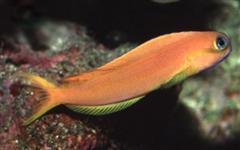Blenny - Midas
Midas Lyretail Blenny, Persian Blenny Scientific Name: Ecsenius midas
Sat, 12th July, 2025 - 5:46 am GMT
Sponsor Ads:

Alternative Name
Midas Lyretail Blenny, Persian Blenny Scientific Name: Ecsenius midasBasic Info
Midas Blennies grow to lengths of 4 inches (10 centimeters). As their name implies, these fish are gold in color but this color changes with their mood. Sometimes a normally goldish colored fish will be a dark greenish-brown! Many have a warm peach colored highlight in the area of their throat. The eyes are rimmed in a bright blue color. Midas Blennies have deeply curved, lyre-shaped tails, and are often known as Lyretail Blennies for this reason.
Health
A single Midas Blenny should have an aquarium between 20 and 40 gallons in volume, with larger sizes being preferred. When keeping other fish with a Midas Blenny it is particularly important that larger aquariums are used, as these fish may behave aggressively towards other fish when crowded. Midas Blennies do well in temperatures between 75 and 78 degrees Fahrenheit (24 to 26 degrees Fahrenheit). Well-lit conditions are recommended. A pH between 8.3 and 8.4 and a specific gravity between 1.020 and 1.025 are appropriate. When kept with other fish, the range between 1.020 and 1.023 is best; however, in aquariums containing invertebrates, a specific gravity between 1.023 and 1.025 will be necessary. Plenty of hiding places should be provided; live rock or corals can make excellent choices for Midas Blennies. The proper diet for a Midas Blenny consists of a wide variety of meat and plant items. These fish will often eat algae. Commonly, frozen herbivore diet, mysid shrimp, brine shrimp, and other crustaceans are also offered.Habitat
Saltwater Fish - found in the Indian Ocean and the Red SeaBehavior
The Midas Blenny is an entertaining captive, with its unique movements and often changing coloration. These fish can be great choices for beginning marine aquarists and advanced hobbyists alike. Midas Blennies swim with a rather undulating motion and have been compared to eels in their movements. They do, in fact, like to rest in crevices or holes in rock, exposing only their heads, to watch their surroundings. Midas Blennies enter these holes not head first, but tail first, backing skillfully into these small areas. These fish are also known to perch on rocky ledges. They are considered to be quite alert and active, and are often the first fish in a community to come to feed when items are placed into the aquarium. Midas Blennies are considered reef safe and can make excellent inhabitants for minature reef and community aquariums. There have also been reports of Midas Blennies nipping at smaller Gobies such as Fire Fish, though such problems seem to be associated with territorial behavior due to overcrowding. Plenty of hiding places and plenty of space should be provided to prevent aggression.Origin
Indo-PacificHistory
Native to the Indo Pacific, Midas Blennies are also found in the Indian Ocean and the Red Sea. These interesting fish can make a good beginner's marine fish, though experienced aquarium keepers also choose them for their interesting habits and coloration.Common Foods
N/ASponsor Ads:
"UNIX was not designed to stop you from doing stupid things, because that would also stop you from doing clever things." -- Doug Gwyn
Blenny - Midas
Coded by: BGID® | ALL RIGHTS RESERVED Copyright © 2000-2025
Disclaimer | Privacy | Report Errors / Contact | Credits








 Why haven't we as a collective earth met with aliens yet?
Why haven't we as a collective earth met with aliens yet?  World EcoSystem - Biodiversity Changes - Who is on board and who isn
World EcoSystem - Biodiversity Changes - Who is on board and who isn  Homosexual behavior stems from the mind or genetics?
Homosexual behavior stems from the mind or genetics?  The Best Text Adventure You Will Ever Play! The official site:
The Best Text Adventure You Will Ever Play! The official site:  Mouthwash - Mouthrinse - Mouth Sores - Healing Infections - Gingivitis
Mouthwash - Mouthrinse - Mouth Sores - Healing Infections - Gingivitis  Treatment for Depression
Treatment for Depression  Ultra radical and violent Islamist group that even rivals Al Qaeda
Ultra radical and violent Islamist group that even rivals Al Qaeda  An idea to have teachers who want to carry guns to school undergo some level of police training will be left up to local school districts and police departments.
An idea to have teachers who want to carry guns to school undergo some level of police training will be left up to local school districts and police departments.